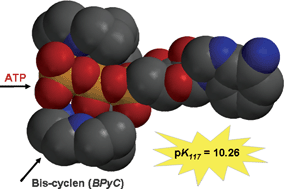Cyclen-based bismacrocycles for biological anion recognition. A potentiometric and NMR study of AMP, ADP and ATP nucleotide complexation†
Abstract
The behaviour of two cyclen-based bismacrocycles linked by aromatic spacers as receptors of

* Corresponding authors
a
UMR CNRS 6521, “Chimie, Electrochimie Moléculaire et Analytique”, Université de Bretagne Occidentale, C. S. 93837, 6 avenue Victor Le Gorgeu, Brest, Cedex 3, France
E-mail:
Henri.Handel@univ-brest.fr
Fax: +33 2 98016138
Tel: +33 2 98017001
The behaviour of two cyclen-based bismacrocycles linked by aromatic spacers as receptors of

 Please wait while we load your content...
Something went wrong. Try again?
Please wait while we load your content...
Something went wrong. Try again?
A. Delépine, R. Tripier and H. Handel, Org. Biomol. Chem., 2008, 6, 1743 DOI: 10.1039/B719514A
To request permission to reproduce material from this article, please go to the Copyright Clearance Center request page.
If you are an author contributing to an RSC publication, you do not need to request permission provided correct acknowledgement is given.
If you are the author of this article, you do not need to request permission to reproduce figures and diagrams provided correct acknowledgement is given. If you want to reproduce the whole article in a third-party publication (excluding your thesis/dissertation for which permission is not required) please go to the Copyright Clearance Center request page.
Read more about how to correctly acknowledge RSC content.
 Fetching data from CrossRef.
Fetching data from CrossRef.
This may take some time to load.
Loading related content
